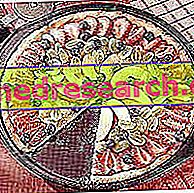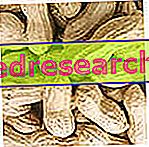Fructose (or levulose) is a monosaccharide, which has the same molecular formula as glucose (C 6 H 12 O 6 ) but different chemical structure. Even its nutritional properties, which have long been the subject of numerous studies and research, are different.
Like all carbohydrates, fructose also provides around 4 Kcal per gram (3.75 to be precise).
Fructose in food Fructose digestion and absorption Fructose and insulin Fructose access Fructose intolerance Fructose and slimming Fructose and diabetes Fructose: endocrine and metabolic effects Fructose syrup Recipes with FructoseFructose in foods
Fructose is present in fruit (to which it owes its name), honey and vegetables. Ripe grapes, bananas and tomatoes are just some of the foods with the highest content of this sugar:
| FOOD | Total glucose (g / kg of food) | Total fructose (g / kg of food) |
| Fruit | ||
| oranges | 29-39 | 31-33 |
| Bananas | 42-62 | 41-62 |
| strawberries | 25 | 20-27 |
| Mandarins | 10-11 | 18-38 |
| apples | 29-32 | 80 |
| Pere | 12.5-16 | 60 |
| Lemon juice | 8-9 | 9 |
| Vegetables and vegetables | ||
| Garlic | 14 | 8 |
| carrots | 23.5 | 23 |
| Lettuce | 2.4-5.1 | 3.1 |
| Eggplant | 13-16 | 12-16 |
| peppers | 15-25 | 13-16 |
| peas | 2.3-19 | 2.25-10 |
| Fresh tomatoes | 13-14 | 15-19 |
| Zucchini | 9.5-11 | 8-12 |
From Food Chemistry - Cappelli and Vannucchi - Zanichelli | ||
Fructose also abounds in many processed foods where it is used to sweeten and to keep foods longer.
Combined with glucose it forms the disaccharide sucrose (the common kitchen sugar) with respect to which it has a superior sweetening power (almost twice as much). It is precisely the abundant presence of fructose that gives honey more sweetness than traditional sugar.

Fructose is normally obtained by isomerization of glucose present in corn starch. At room temperature, due to its high solubility, it is in liquid form. Through the refining process, however, white crystals similar to sugar can be obtained.
Corn starch is also used in the industrial field to produce corn syrup which is composed of 55% fructose and the remaining 45% glucose.
As we have seen, the presence of fructose prolongs storage times and prevents crystallization (a particularly useful aspect in sugary drinks).
Corn syrup is contained in sweets, soft drinks, sweets, fruit juices, breakfast cereals, diet foods and energy bars. Its use in the confectionery industry is essential because the low cost and the valuable characteristics are perfectly combined with the business needs.
Digestion and absorption
To learn more, consult the article: fructose absorption and metabolism
If ingested by itself the fructose reaches unchanged up to the small intestine where it is absorbed and conveyed towards the liver.
Its absorption rate is lower than that of glucose and sucrose but still greater than that of artificial sweeteners recommended for diabetics (polyalcohols).
Thanks to this relatively rapid absorption fructose does not have the laxative effects typical of artificial sweeteners. However, if taken in excess it can exceed the maximum absorption capacity going against a rapid fermentation that causes flatulence and intestinal pain.
The liver has the task of metabolizing fructose, turning it into glucose which, due to the slowness with which it is produced, is slowly poured into circulation.
However, this transformation capacity has a limit and, if present in excess, fructose is converted into lactic acid or triglycerides which will then be released into the blood or deposited in the liver (see hepatic steatosis). Hypertriglyceridemia (high amount of triglycerides in the blood) is one of the main risk factors for cardiovascular diseases (the other blood lipids, such as cholesterol or HDL are not affected in any way by fructose metabolism). Furthermore, the excess of triglycerides is taken up by the cells that deposit fatty acids in the form of adipose tissue.
Continue: Is Fructose Bad? Does it make you fat?
Apple Tart without Sugar with Fructose
Recipe to prepare a light apple tart, without sugar and with fructose explained in every detail by Alice, our PersonalCooker. Follow the other video recipes with fructose and alternative sweeteners on MypersonaltrainerTv.
Pear Cake for Diabetics
X Problems with video playback? Reload from YouTube Go to Video Page Go to Video Recipes Section Watch the video on youtube



